












BY JEREMY OSTERHOLM, OSTERCRAFT HOMES & 1915 EXCAVATION

It’s coming up on election season and the HBA is hard at work on behalf of all our member companies. We are facing some serious challenges as business owners and voters this year, including an attack on corporations once again with a huge statewide corporate sales tax ballot initiative called IP17. Whether you pay it directly or see increased costs due to companies you work with who have to pay it, the bottom line is it will impact almost everyone and will cost consumers money. You’ll be receiving a lot of information on important items like these over the next couple of months, so please make note and get involved when asked. It will take us all to fight some of these off.
One of the biggest things you can do to make a difference is to help us pursue new members. Our organization is one that literally gets stronger with numbers. We are an advocacy group for the entire industry, even though our membership represents just a fraction of the totality of our industry
You would be surprised how many companies you do business with aren’t members. Can you imagine how strong we would be if our organization was twice the size? Even just doubling our capacity to advocate for our members and industry would give us amazing resources to represent and fight for housing issues and your businesses.
This Fall we are staging our largest member drive since 2019. We’ll of course have special promos to incentivize sign-ups, and the advocacy
and policy work alone is worth it from my perspective. But the reality is membership dues can in many cases be offset with savings in our daily business as a result of HBA’s great business benefit partners.
When asked “Why should I join?”, here are some talking points I use:
1. Be a part of the solution in a difficult region and State to operate a business
2. Be a part of the solution for all things housing
3. Join our SAIF workers comp program for a discount of 7% (this is up from 2% last year)
4. Join our Fuel program and save nearly $.50 a gallon, an average of $600 in fuel cost savings per year per vehicle!
5. Join our BIIT medical insurance Trust with Regence and save thousands on medical insurance and related health care benefits for your staff
6. Free and discounted continuing education on building issues and to get or maintain your CCB
There are many more reasons and other cost-saving benefits, but these are a few of the highlights.
Let’s break records this Fall and get some of those companies that sit on the sidelines to join, spreading the workload and increasing HBA’s resources for the rest of us who are already members. Who do you work with that isn’t a member? Who do you know that is benefitting from our advocacy without paying their dues? Reach out to Rachel Trice (rachelt@ hbapdx.org) or Tami Walter (tamiw@hbapdx.org), and they will be happy to review any supplier or customer lists and let you know who is or isn’t a member. They can also set you up with some easy resources to help promote membership or connect you with one of our teams for this Fall’s Drive. Not only will you help us be stronger for your business, but you will also make some new connections and learn more about the services and benefits HBA can offer your business and team.
Let’s capture these potential members this Fall!




















BY: TERESA SPANGLER, HBF WORKFORCE AND COMMUNICATIONS COORDINATOR
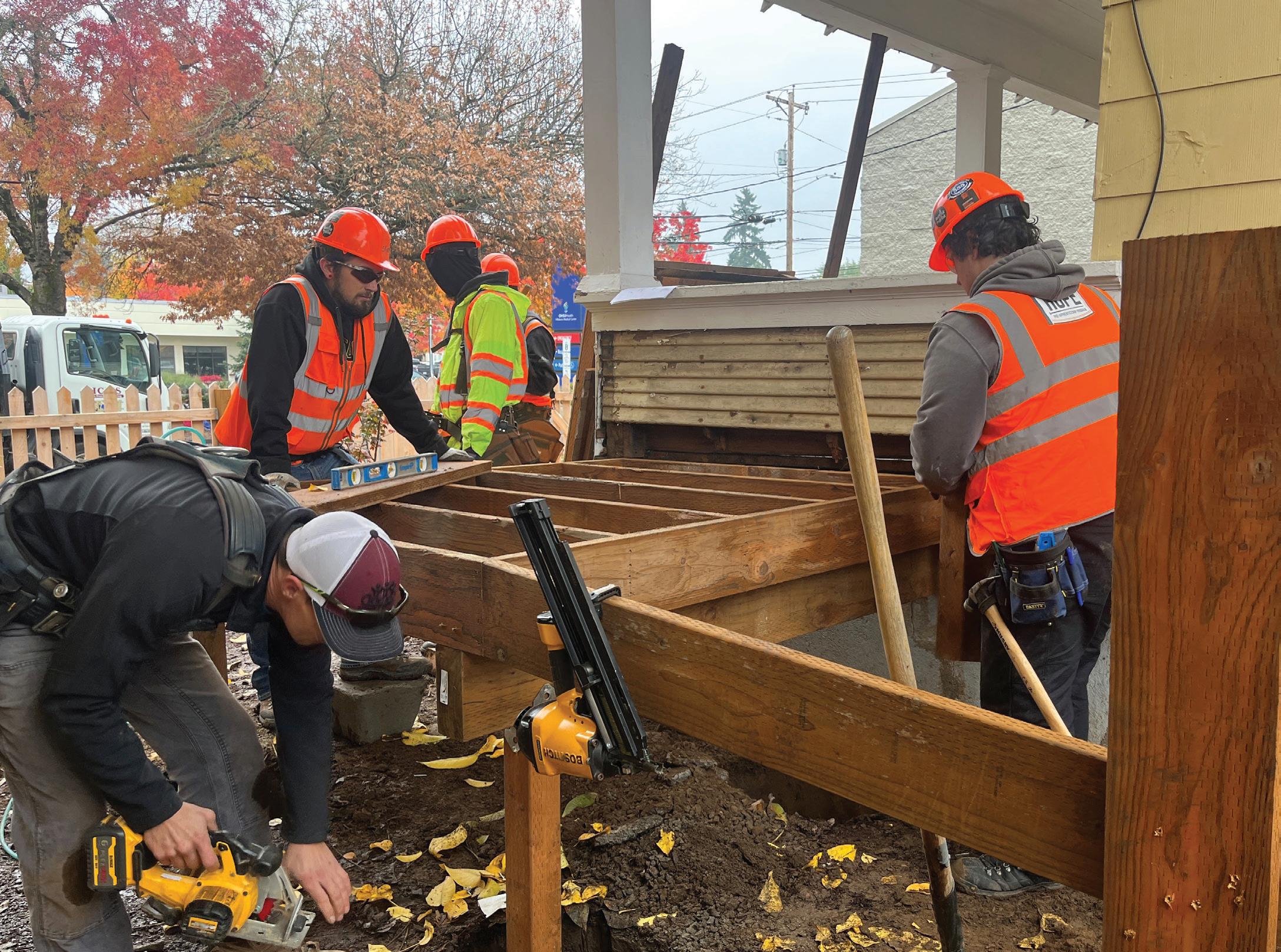
Portland’s recent housing deficit and construction labor shortages led HBA and HBF leaders to conclude that much more needed to be done to encourage people to pursue careers in the home building industry. Workforce Development has been a core mission of Home Building Foundation since it began in 1997. For a long time, HBF primarily focused on providing college scholarships, giving more than $300,000 to high school students interested in construction-related fields. In the face of growing demand, HBF began developing plans to motivate, train and connect more people to careers in construction.
The timing was right for the push. Oregon voters approved Measure 98 in 2016, the “High School Success Act”, which funded the expansion of career training education. There are now nearly 40 area high school construction programs in the Portland Metro area, as well as community colleges, and four adult pre-apprenticeship programs. HBF strategized that it could build relationships with the training programs and their
students by involving them in our unique shelter building projects.
HBF began with a mailing to the high schools at the beginning of the school year three years ago, asking them to help HBF’s collaborative work with HBA members to build and remodel homeless shelter facilities. Sam Barlow High in Gresham and Reynolds Learning Academy volunteered, and HBF provided materials for students to build sheds for two of our ongoing projects. In the spring of 2022, HBF won a National Housing Endowment Career Connections grant to pilot the “Picnic Table Project.” Picnic tables seemed to be an easier project that more schools could handle. With the grant funds, we purchased materials for four programs, resulting in 15 tables donated by HBF to transitional housing villages.
Fast forward to the end of the 2023-24 school year.
Grants from U.S. Bank, Maybelle Clark Macdonald Fund, and individual donations have helped HBF purchase materials from local suppliers for projects that have been completed
by nearly half of the area high schools. Hundreds of students have built tables, seating, sheds, and even bee keeping houses for shelter facilities. The HBF Education Partnership Program has now placed student-built tables at every “Safe Rest Village” in Portland, which house people transitioning out of homelessness.
Students tell us they are excited about the work, and so are their teachers. Reynolds Learning Academy Trades Program Director Angie Gilbert says “We are happy to support HBF, we feel that what we are doing for shelters is very important.” Other teachers told us because of high material costs, students often had to take their mockups apart to preserve lumber. Schools tell us they welcome meaningful, projectbased learning., and report students are more engaged with these HBF collaborations.
The Education Partnership Program has increasingly involved the help of experts from the residential building community. For example, trainees from adult pre-apprenticeship program Constructing Hope helped build platforms for tents for the city of Portland’s Clinton Street Shelter, learning framing techniques from HBF’s Project Manager Chris McDowell. Another Constructing Hope cohort helped build a wheelchair ramp for Project Homeless Connect, with instruction from HBA members Rick’s Custom Fencing and Decking. Carpenters from Holt Homes helped Reynolds Learning Academy students build a coffee cart and trash enclosure for Cultivate Initiative’s work program.
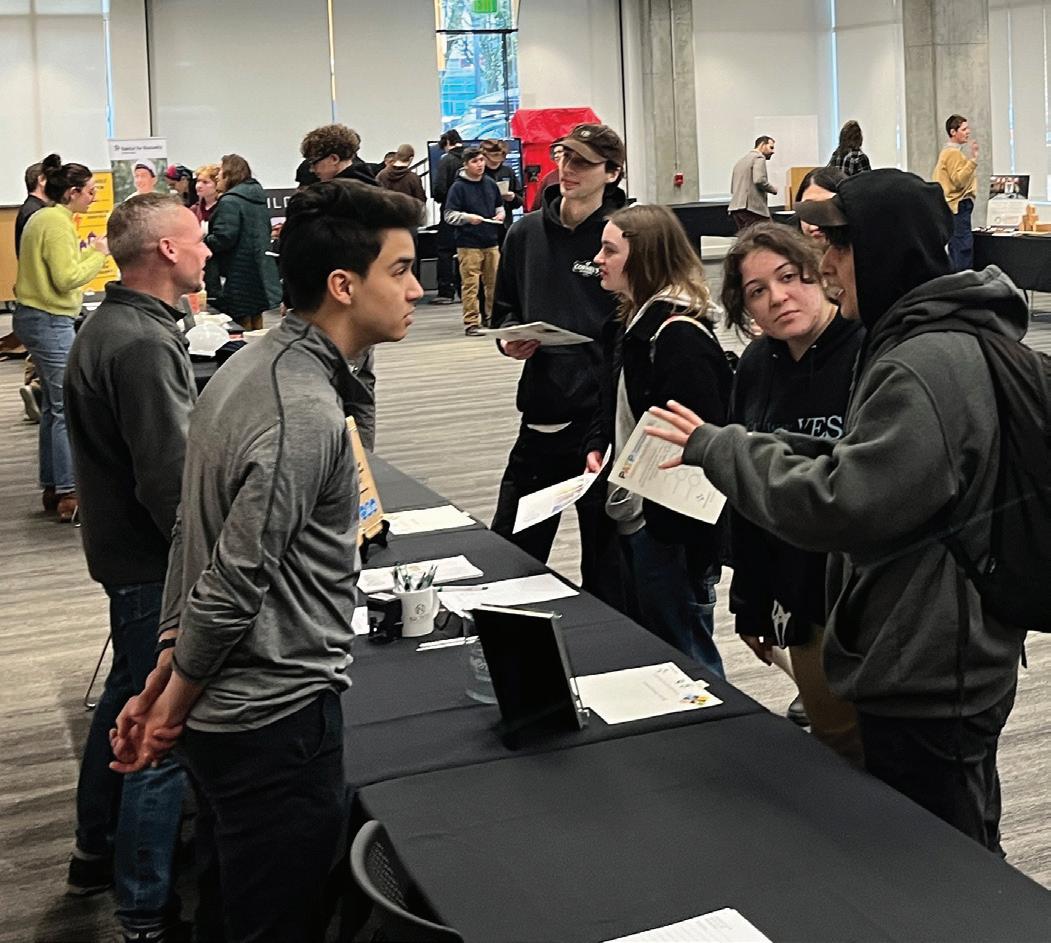
The Education Partnership Program is a companion to joint HBA and HBF efforts to prepare students for careers in sustainable building. As a result of a grant from the Portland Clean Energy Fund, our organizations are providing career connections to pre-apprenticeship students from Constructing Hope, Oregon Tradeswomen, P.O.I.C., and Portland Youth Builders. Graduates have been invited to attend HBA’s annual BuildRight Conference + Expo to learn more about sustainable building techniques. HBF and HBA have also coordinated three career fairs to introduce trainees to future employers. More than 80 trainees attended our job fair this spring at NW
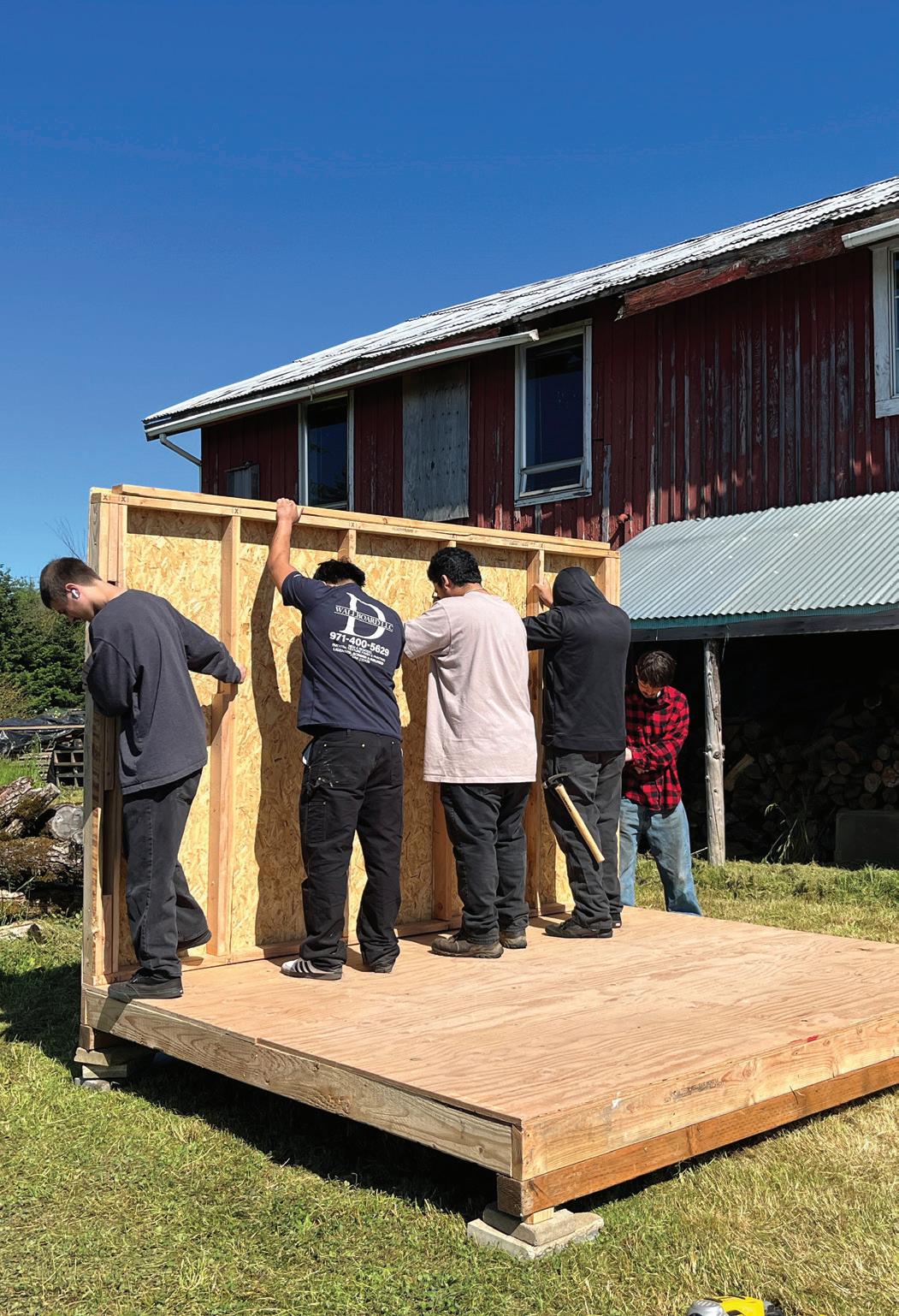
HBF continues to evolve the Education Partnership Program, with a goal to ensure students are trained in the most current building techniques they may see in residential construction. This spring, HBF dropped off lumber with teacher Josh Hardy at Sam Barlow High so the kids could build a shed for Blanchet Farms. HBF had the lumber pre-cut at Builders FirstSource’s Clackamas facility, introducing them to the “Ready- Frame” system. For Barlow teacher Hardy, having the project come in kit form helped his students complete the project quicker. The students also experimented with building the shed in panels, which made it easy to transport from their school in Gresham to Yamhill County, where they completed their assignment. Hardy says “my students all had a great time and an excellent learning experience for them!” HBF credits HBA member Jon Girod for encouraging modular shed building, which he is championing to schools in SW Washington.
The Education Partnership Program will take another leap forward this summer, when students become our true partners in building housing for people experiencing homelessness. In July, training program P.O.I.C will work with HBF to build a prototype sleeping pod for Cultivate Initiatives. Cultivate Initiatives hopes to develop a housing village of up to 20 pods on its headquarters property at 146th and SE Stark. Its proposed Workforce Village will house participants in its innovative “Intern” program, which hires people who were formerly unhoused work in the community to clean graffiti, pick up trash, and to provide light construction. HBF will watch Story continued on page 6
the program closely, with the intention to create a template so other school partners could help us build tiny homes to shelter people now living outdoors.
HBF’s hopes to expand the Education Partnership Program to involve additional schools because of its many benefits to the Portland community. Our nonprofit partners tell us the projects students build help them provide comfort to people experiencing homelessness at this time of overwhelming demand. The projects students build for shelters help engage and inspire the next generation of home builders. We are touching the lives of many youth and young adult trainees, providing them with tools, materials, professional expertise, and employment opportunities. Over time, we believe we will connect them with work in home building that will bring them living wages and rising prosperity for their families.
The National Association of Home Builders (NAHB) awarded the Home Building Association and the Home Building Foundation of Greater Portland an Association Excellence Award this past May for “Best Workforce Development Plan Implemented”. HBF submitted its Education Partnership Program for consideration, saying it “inspires students to pursue careers in residential construction through project- based learning.” HBF and HBA members provide materials and give their time to help construction students build meaningful projects that are donated to homeless shelters. HBA CEO Dave Nielsen praises the award, saying “I want to thank HBF and the HBA team for their work to elevate this as a priority and make some real progress in what is understandably a long-term play to increase the future workforce in our industry. This is a very tough award and category to win, as home building associations nationwide are trying to combat a worker shortage. For HBF, we see the Education Partnership Program as a perfect companion to our shelter building. Ultimately, providing opportunities for people to secure living wage careers in residential construction will help them avoid housing insecurity, which is an important companion to HBF’s shelter work.
INDUSTRY EXPERTISE IS VITAL TO THE SUCCESS OF THE HBF EDUCATION PARTNERSHIP PROGRAM. YOU CAN HELP BY
• Participating in a job fair
• Hosting tours of your workplace
• Creating internships or paid work experiences
• Providing materials or expertise for classroom projects
• Serve on an Advisory Board for your local high school construction program
If interested, contact HBF Workforce Coordinator Teresa Spangler at Teresas@hbapdx.org.
By Brenda Ketah, HBF Executive Director
I am gratified that the Home Building Foundation and Home Building Association of Greater Portland are making a joint effort to increase our focus on Workforce Development. This spring, I attended the Oregon Talent Summit in Salem, a twoday meeting with more than 400 leaders in education and employment. There, researchers unveiled the “Oregon Talent Assessment 2024”. Four industry clusters were listed as offering “upward mobility and strong career pathways to workers in Oregon: health sciences, information technology and analytical instruments (much of which is manufacturing); construction; and wood products manufacturing.” However, the same study found there is a lack of interest and negative perceptions about the trades industry, making it difficult to connect younger people with training opportunities in construction.
HBA and HBF are working together to remove roadblocks. In the past three years, we have developed relationships and work directly with four strong adult preapprenticeship programs in our region and with nearly half of the Portland area high school construction programs. We try to inspire students by involving them in meaningful construction projects, giving them connections to member companies with job opportunities, and engaging them in HBF’s work to build, remodel and repair shelter facilities for Portlanders experiencing homelessness.
We welcome your partnership. Consider joining our Workforce Development Advisory Group, which meets quarterly. HBF can help you coordinate a student tour, involve your company in a classroom project, or facilitate your participation in a hiring fair. Together, we can build the residential construction workforce of the future.








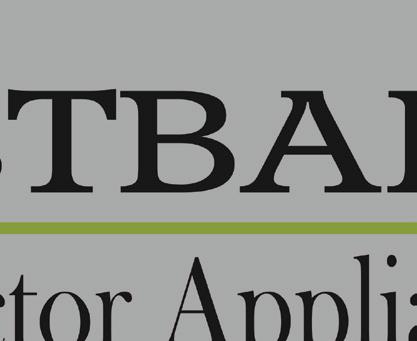



Detailed Product Knowledge from Oregon's Largest Sub Zero & Wolf Builder Supplier Experience Quality Trust
Appliances You'll Find the Very Best Detailed Product Knowledge from Oregon's Largest Sub Zero & Wolf Builder Supplier Experience Quality Trust

800 SE Hawthorne Blvd just 3 minutes from Downtown Portland 503.954.1192
800 SE Hawthorne Blvd just 3 minutes from Downtown Portland 503.954.1192
www.eastbankappliance.com Open to the Public 8:30 to 5 Mon - Fri Saturdays by Appointment
www.eastbankappliance.com Open to the Public 8:30

PRESTON KORST, HBA DIRECTOR OF POLICY AND GOVERNMENT AFFAIRS
HBA is monitoring closely and beginning to coordinate strategy for several important taxing measures that may be heading to voters as early as this November. Below is a description of two measures that could have serious implications for your business and for residents across the state and region.
17: An Experimental ‘Universal Income’
Initiative Petition 17, also being referred to as the “Universal Income” tax, is a proposed statewide measure that is currently gathering signatures to appear on the November ballot. The measure would establish a 3% corporate minimum

Minimize liability and reduce financial risk.
Attract more buyers and boost value.
Wide range of warranty options and terms.
tax on all Oregon gross sales above $25 million in order to fund a universal income program for ALL Oregon residents, regardless of income. The estimated dollar amount that the program would fund would be roughly $750 per person annually.
The ‘yes’ campaign working to support the measure is being referred to as “Oregon Rebate 2024” and is being funded almost solely from out-of-state money, primarily from shadow groups operating out of California. Despite not knowing that the measure will actually appear on the ballot, the lead business group coalescing a campaign to defeat the measure is likely to be Oregon Business and Industry. HBA and our partners in the business advocacy community are currently assessing options and strategies to defeat the measure in the fall. Given the proposed structure of the measure, it could be disastrous for local businesses and employers, particularly for homebuilders, whose high-volume operating models (i.e. sale of homes) would be disproportionally impacted by this tax, further exacerbating the housing affordability crisis gripping our state.
Large Oregon-based companies have signaled that they take this as a serious threat and there is already talk of raising millions of PAC funds to beat it in November. HBA and OHBA will coordinate our support to ensure our members are aware of the impact this could have to the industry and on housing.
receipts of more than $5 million.
The basic goal of the exploratory group meeting with Metro leadership has been to address the serious issues of the SHS program and tax that have arisen in the last several years, particularly the lack of accountability at the local level, the inability of counties to spend resources on basic services, and the growing problem of unsheltered camping in public spaces. So, for the last six months, Metro has gathered several stakeholders (HBA included) to vet proposals to reform the measure to make it more effective, with the added benefit of potentially lowering the region’s tax burden. The current tentative agreement being worked out calls on several reforms to the measure, including:
• Greater oversight of county ran programs, including how and where money is being spent, and more accountability in creating shelter beds that will reduce unhoused homeless populations.
• Transferring excess revenues (which have topped hundreds of millions) to the creation of affordable housing development and infrastructure, including innovative capital projects that support greater regional housing affordability.
• A reduction in the tax rate for individuals, including a one-time increase to the income eligibility thresholds with annual inflationary indexing to give tax relief to residents.
John Felbaum / 800.247.1812 x2633 sales@rwcwarranty.com www.rwcwarranty.com
HBA has been involved in several workgroups assessing the path to reforming Metro’s Supportive Housing Services Measure, the tax passed in 2020 that funds homeless services through the counties. The current program collects a 1% tax on all taxable income of more than $125,000 for individuals and $200,000 for joint filers. It also collects a 1% on profits from businesses with gross
• Extending the tax’s sunset from 2030 to a later date, in order to ensure the long-term funding mechanism is more assured to county operators of homeless services and matches requirements for bond obligations for affordable housing projects.
As with all of HBA’s advocacy work, if you or your company is interested in learning more or supporting our efforts to create a stronger market for homebuilding, please reach out! Preston Korst, HBA’s Director of Government Affairs can be reached at prestonk@ hbapdx.org.
Following several quarters of construction slowdown in Portland, the Bureau of Development Services (the city’s primary permitting agency) saw a significant reduction in revenue and was forced to lay off 72 employees in December. This was the city’s first attempt to stem the tide of BDS’ rapidly shrinking reserves and help stabilize its budget. However, that has proven insufficient as further talks of layoffs remain probable if further action is not taken. While in the past year, Portland has achieved significant strides in improving a historically dysfunctional permitting agency, there is concern among the industry that further layoffs would derail that progress and return to an era of months-long wait times for residential permits. To help prevent this, HBA and a coalition of partners entered into discussion with city leaders to form a plan that would stabilize budgets, prevent further layoffs, and create new efficiency measures to existing operations. As part of these conversations, our proposal includes a $6 million general fund allocation, a modest agency-wide fee increase, and implementation of new efficiency tools like selfcertification, third-party reviews, and permitting “shot-clock” deadlines. While this plan is still being vetted, we are confident that City Council and BDS leadership will develop an equitable proposal that includes new investments that incentivize new housing production.
HBA Members Shape Metro Homeless Services Funding Proposal HBA has been working among a group of business and advocacy groups to help shape negotiations that could re-appropriate how and where Metro’s homeless services funding is spent. While conversations are still early, Metro and a task force of two dozen organizations have convened to evaluate whether to appropriate surplus taxing revenues towards housing production given that the 2018 Affordable Housing Bond is nearing its conclusion. At the core of the issue is a near $1 billion surplus that the SHS tax is expected to generate over the next decade, on top of the projected collection of $250 million per year for approved countydirected services. While there are strong differences of opinion on the matter, there has been clear evidence of counties struggling to deploy the resources they’ve received.
HBA will continue to engage in these conversations and will work hard to ensure that we see relief from excessive regional and local tax rates while also encouraging precious public resources are leveraged in a way that incentivizes housing production across the region. We will continue to keep our members informed about any further discussions.
HBA has been working with several industry and housing groups to shape negotiations that could re-appropriate how Metro’s Supportive Housing Services (SHS) tax funds are spent. Metro and a
taskforce of two dozen individuals and organizations are evaluating whether to spend surplus revenues on new housing production given that the 2018 Affordable Housing Bond is nearing its conclusion after having created over 4,800 new affordable homes across the region.
At the core of the issue is an anticipated $1 billion, 10-year surplus that the SHS tax is expected to generate, on top of the projected collection of more than $250 million per year for countydirected homeless services. Many involved in the stakeholder table believe that the overall tax rate should decrease, offering tax-relief to Portland area residents, while redirecting surplus funding to programs that have a detailed track-record of success.
While there are ideological differences of opinion on the matter, some, including Governor Kotek have weighed in with support for potentially using some funds for the construction of new housing. At any rate, it is clear that counties have struggled to deploy taxpayer dollars effectively, ending up with hundreds of millions sitting in county bank accounts. HBA and several of our members have a seat at the table and will work to ensure that precious public resources are spent responsibly, and leveraged in a way that incentivizes housing production across the region.
On April 12th, the City of Portland’s Bureau of Transportation released new administrative rules that guide thresholds for how frontage improvements and dedication requirements are approved. This new administrative rule, TRN-1.30, describes the two thresholds used by PBOT to determine when frontage improvements or right-of-way dedication are required, including how each threshold is calculated, what’s required when the thresholds are met, and exemptions. According to the city, this new rule “largely reflects current practice, with some updates including to better align with the city’s Transportation System Development Charge program and to reflect recent policies including middle housing”.
For the past several months, HBA and a group of about a half dozen members have been working closely with the City of Wilsonville’s engineering teams to address the critical funding gaps that exist to install the infrastructure necessary to develop key areas within the Frog Pond East and South area. In order to get residential development (that is, new homes) built in this recently approved expansion area, the city and developers are working in good-faith towards an plan that we hope will balance the mutual public responsibilities for what is developer-mandated and creditable, what are the city obligations, and how can Capital Improvement Project scopes and external funding sources be considered in order to turn prime, undeveloped land into desperately needed new housing. We will continue to update our membership as progress is made. If you would like to learn more about these ongoing discussions, please reach out to Preston Korst at prestonk@hbapdx.org.


This summer, the NW Natural Street of Dreams is ON TOUR! Because DREAMS look different.
Presented by Community Financial/Banner Bank and Standard TV & Appliance
August 1 – August 18, 2024 | Thursdays – Sundays
10:00 AM – 8:00 PM Thursdays – Saturdays 10:00 AM – 6:00 PM Sundays








As the event approaches 50 years in production, the NW Natural Street of Dreams® realizes that dreams look different these days. With single-site land developments being harder to find, rising housing costs, and higher interest rates, the highly anticipated annual summer home tour changes to an ON TOUR format and focuses on a variety of housing types and budget ranges.
This year, we are taking the show on the road. it’s time to explore! Join the 2024 NW Natural Street of Dreams® ON TOUR edition running for three extended weekends August 1 – August 18! Experience the beauty of the Pacific Northwest and the quality craftsmanship of our region while discovering new communities and housing options in neighborhoods including Portland, Hillsboro, Sherwood, Lake Oswego, and more! Find your dream home or




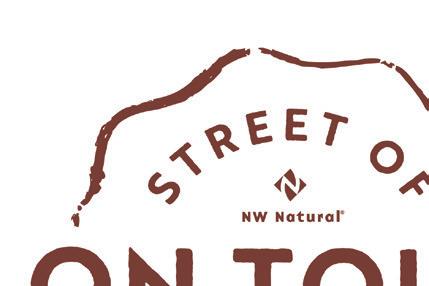





builder today! The annual home tour, produced by the Home Building Association of Greater Portland, offers a unique opportunity for home inspiration, showcasing the latest in design trends and technology for three weekends only, this summer.
One single admission ticket for $27 gains access to 20+ locations showcasing more than 10+ builders on the 2024 tour and provides free experiences along the way. The 2024 show presents a diverse array of stunning single-family new construction homes that attendees would expect to see on an annual Street of Dreams tour but the new ON TOUR format now also features new residences ranging from luxury custom-built homes to high-end condos and apartments. Plus - new this year – the show will offer a more affordable housing option to view – what’s considered “middle housing” options in Portland including





duplexes, cottage clusters, and townhomes that have become an important piece of the solution to the housing affordability issue in our region.
Spread around the greater Portland area, this three-week event aims to illustrate that dreams come in diverse sizes and styles and is sure to inspire everyone, no matter the budget. Whether you are looking to experience the latest in design trends up close or are looking to buy your first home and want to see the newest and most accessible offerings to first-time homebuyers. This year at the NW Natural Street of Dreams, $1.00 of each ticket is donated to the charitable arm of the HBA, the Home Building Foundation (HBF) in support of their projects that help the community and those in need on their journey to discover their own dream.
Today, many Oregonians face high housing costs because the supply of diverse housing is so low. For a variety of reasons, the construction of more traditional housing types like single-family homes and apartment complexes has remained the primary form for any new housing built in the last several decades. However, given the growing housing crisis, Oregon became the first state in the nation to re-legalize another form of housing, often called “Missing Middle Housing.”
These building types, such as duplexes, triplexes, fourplexes, cottage clusters, and courtyard buildings, provide diverse housing options while supporting active public spaces and locally serving retail. By using urban lands more efficiently, these housescale buildings fit seamlessly into existing residential neighborhoods and help reduce the environmental impact of housing by supporting walkability and public transportation options. These products tend to produce slightly smaller home sizes, which can provide more affordable and accessible

housing choices for people earning lower and moderate incomes.
“The creation of new, high-quality middle housing types is essential to addressing our region’s severe housing crisis and undersupply problems,” said Preston Korst, Director of Public Policy and Government Affairs at the Home Building Association of Greater Portland. “Middle housing has the potential to create a new era of genera-
The City of Portland incentivizes the creation and sale of affordable middle housing through the use of its Homebuyer Opportunity Limited Tax Exemption (HOLTE) and System Development Charges (SDC) Waiver Programs. While quite technical, these tools are unique from other programs because they offer both developer-based incentives as well as homebuyer subsidies.
SDC Wavers help offset or eliminate the builder’s responsibility to pay for System Development Charges (also known as impact fees) that can run upwards of $50,000 per unit. The HOLTE program offers a sizeable 10-year property tax abatement to any prospective homebuyers earning a low income (less than 100% of Median Family Income, which is about $114,400 for a family of four).
These programs require that all homes be sold to qualified buyers at no more than $455,000. This program has been instrumental in catalyzing the market to invest in the creation of starter homes and first-time homeownership—an incredibly difficult product to make. As a result of these programs, we’ve seen affordable homes being built and sold to many in
our community who would never have been able to afford to own a home in this market environment. The City of Portland’s creation of these successful, innovative tools is a great example of public-private partnerships that deliver tangible benefits to our underserved communities.
This year, the NW Natural Street of Dreams is showcasing four builders who are actively supplying Portland residents with move-in ready, modern, and affordable middle housing options including cottage clusters, duplexes, townhomes, and container homes. Dez Development, Aker Development, Fish Construction, and Relevant Buildings are leading the local Portland market in their contribution to accessible housing options to make first-time homebuyers’ dreams come true. As the economy continually changes and home ownership remains a pipe dream for some of the younger generation of home buyers, Portland’s growing inventory of middle housing options is a hopeful solution to the evergrowing housing affordability crisis. This year, following the theme that dreams
tional wealth for communities that have been traditionally left out of the benefits of homeownership.”
Combined, these newly re-allowed housing types will impact the market by addressing the mismatch between the available U.S. housing stock and shrinking household sizes, all while encouraging more entry-level and age-in-place homeownership opportunities.
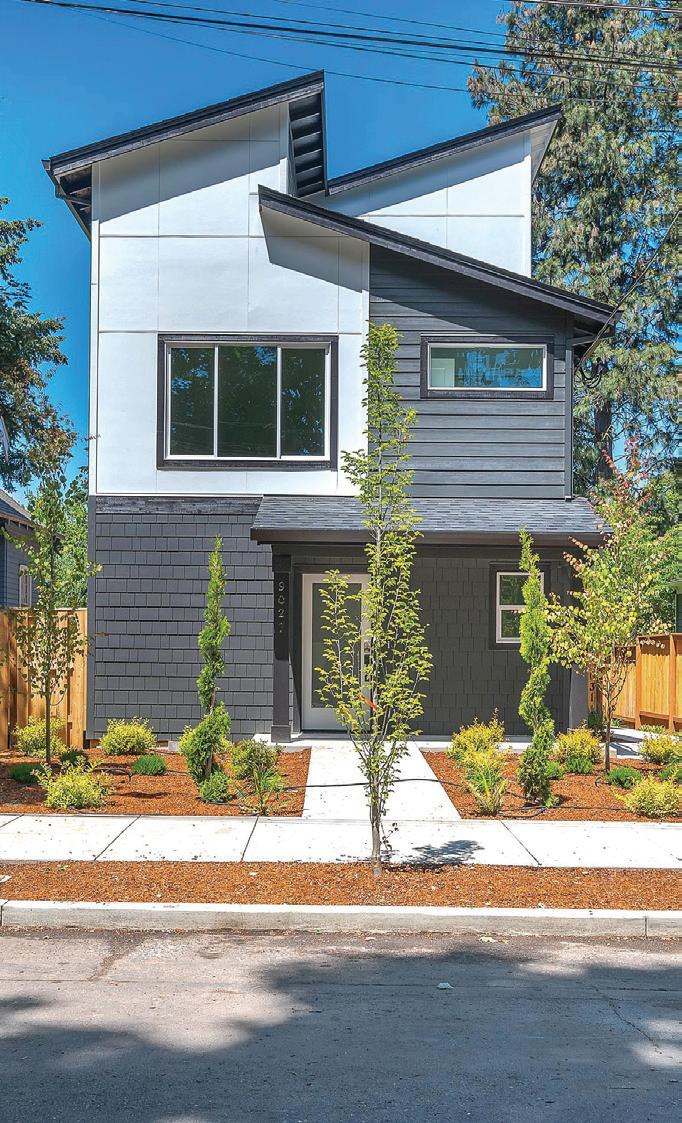

look different to everyone, we are proud to feature these housing options as a benchmark for what Portland can do to help alleviate the housing crisis.





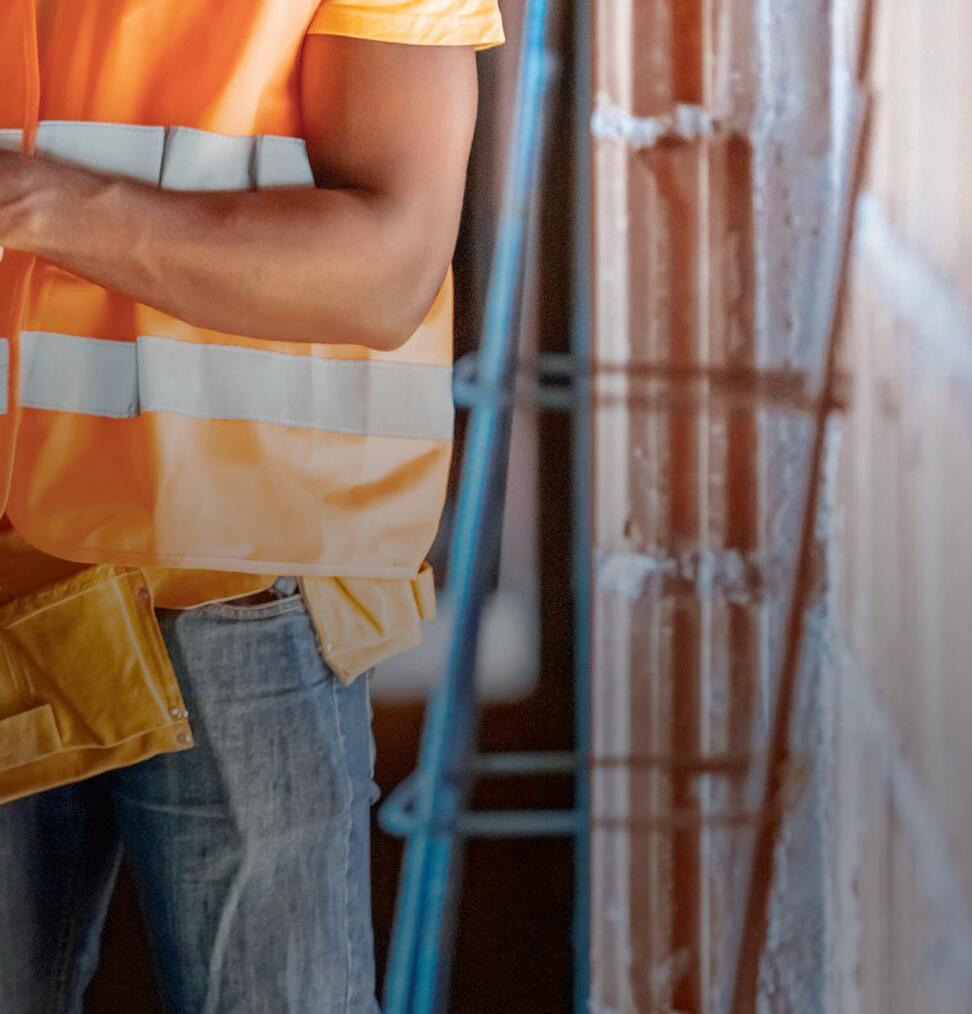
The Home Building Association of Greater Portland has partnered with Regence BlueCross BlueShield of Oregon and Capital Benefit Services to bring members more affordable health care through the Building Industry Insurance Trust. HBA members deserve a health plan that's tailored to your industry and focused on the well-being of your employees and your business. Powered by the most trusted name in health insurance, your plan offers access to a broad provider network and support from an award-winning customer service team.
To learn more or get a quote, visit buildingindustryinsurancetrust.com or call (425) 641-8093.
BY: CAROL EISENLOHR, BUILDING TOWARDS BETTER LLC AND HBA BUILDING SCIENCE CONSULTANT






I was doing some research on the BetterBuiltNW website when I ran across the article they posted on BuildRight 2024 titled “What to Expect From the Revamped BuildRight Conference” and it made me get excited about planning for the 2025 BuildRight Conference. The partners, sponsors, and speakers have helped make BuildRight into a regional conference where industry professionals can come together learn, share ideas and information, and network.
During my 25+ years as a builder, there has never been a time when we have so many good resources at our fingertips on the internet. Resources, education, and innovative tools are the backbone for builders to be successful. The challenge is finding details and information that you trust from proven systems. How do we keep up with all the innovative tools at our disposal that could make us more efficient in this fast-moving construction industry? It all takes time to pull together, time away from our job site, and time away from our families.
Below are some free resources that might help with the challenges you face every day in building a better home for your clients.
AceLabs is a great resource for building science-influenced design. Christine Williamson our Keynote from BuildRight 2023 joined Acelab in 2022 to lead building science education and create free, ondemand lessons that Architects and builders can use to build better homes.
BetterBuiltNW is a great free online resource with many details and case studies that lay out some of the challenging changes builders run into when building a tighter more energyefficient home. Their online library is wellorganized and user-friendly. BetterBuiltNW was also a partner for BuildRight 2024.
Construction Instruction App is an amazing tool to use out in the field when you need to review an installation process to understand it better or share it with a subcontractor. I used the animated Tyvek details many times to show an installation process when the siding team and I had communication barriers. Pictures are worth a thousand words. Mark LaLiberte one of our BuildRight 2024
Keynotes cofounded and is president of Construction instruction.
Hammer & Hand has their Best Practice Manual online and shares it with anyone who would like to benefit from their experience.
I have also shared Legend Homes Best Practices and Templates for Scopes of Work along with One Page Quality Checklists for 40 stages during new home construction. Just email me at buildingscience@hbapdx.org and I will send you a copy of any or all.

The HBA Building Science Program is a technical resource available to HBA members free of charge, funded in part by Energy Trust of Oregon, Home Certified, OrePAC, Portland General Electric and NW Natural. If you would like to utilize the Building Science Program to create a continuous improvement plan focused on your building challenges or a plan to prepare for future code changes, contact Carol Eisenlohr, HBA’s Building Science Consultant at carole@ hbapdx.org or call to schedule an appointment at 503-710-2910.
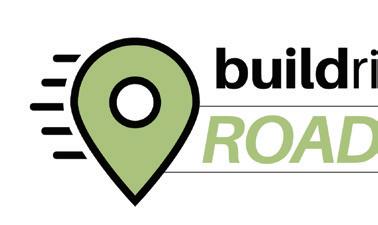

HBA’s Home Performance Council & Building Science Program is bringing you a little BuildRight all year long! Join us for valuable CCB-accredited education and stay for networking with your industry peers. For questions about when the next BuildRight Road Show is scheduled, contact HBA’s Building Science Consultant Carol Eisenlohr at 503-710-2910 or buildingscience@hbapdx.org.
SAVE THE DATE FOR THE 2025 BUILDRIGHT CONFERENCE + EXPO
April 29th
Pre-Conference Educational Track by THE Energy & Environmental Building Alliance (EEBA) April 30, 2025 - May 1, 2025
BuildRight Conference + Expo May 2 – May 4, 2025
The Homes of Tomorrow Today (HOTT) Tour





The Oregon Home magazine Structure and Style Awards recognizes the outstanding work of local companies across a variety of categories, including new residential construction, remodeling and design. Winners are selected by a panel of industry professionals. For more information visit www.ohssawards.com
BY TERESA SPANGLER, HBF STAFF
Home Building Foundation will impact the lives of hundreds of people experiencing homelessness after its 2024 Building Hope Gala and Auction. More than $500,000 was pledged during the annual dinner and auction June 1 at Tumwater Vineyards in West Linn. Presenting Sponsor Ridgecrest Custom Cabinetry helped host an evening to remember, with more than 350 guests dressed in white filling the giant tent. Along with fabulous trips and experiences, the live auction offered a meaningful opportunity for supporters to help people living outdoors. Salem based Sackcloth & Ashes creates beautiful Italian made blankets, and donates a blanket to shelter organizations for each one sold. Founder Bob Dalton told the Gala guests he began his company after his mother briefly became homeless, and introduced his mother in the audience. Dalton offered to donate five blankets for each $100 voucher sold the night of the Gala in celebration of the companies 10th anniversary. As he spoke, models draped in the blankets walked around the tent. When bidding opened, bidders raised a sea of paddles from nearly every table, with some guests buying multiple blankets. In total, 360 vouchers were sold, which means 1800 blankets will be donated to local service providers.
Auction Chair Sybil Fontaine says she is so touched by the response “It is amazing to see people dedicated to giving back with open hearts”.
Guests learned more about the HBF’s work in the community with a video by the AV Department focusing on a recent remodel for Project Homeless Connect in Hillsboro. Hundreds of volunteers gave their time, and materials to bring an estimated $250,000 of value to remodel the aging bungalow. Thanks to our supporters, the building got a new roof, and a much-needed wheelchair ramp. Project Homeless Connects Executive Director Kim Marshall told the audience “It’s amazing when you


see your community come together… homelessness affects all of us. Why not work together?” After the video was shown, inspired auction-goers donated nearly $200,000 during the paddle raise. HBF’s Fund Development manager Kyle Ellerbe says he is amazed by the sold-out event. “The residential building community loves attending, but they show us a lot of love,” said Ellerbe. “At every one of our Galas, they open their wallets beyond my wildest dreams.” The
funds raised by the Gala are leveraged well by the Foundation. Each HBF project saves nonprofits an estimated 30-70% of typical building costs. Student groups are now in the mix, building meaningful items such as picnic tables service providers need. More than 60 organizations and more than 90 projects are in use around Portland because of HBF’s impactful work. HBF’s successful Gala ensures we can continue to build a brighter future.

Home Building Foundation likes to thank some of our outstanding volunteers by declaring them
“Foundation Heroes”. We’d like to introduce you to someone who has gone above and beyond to help our projects in the past two years. Erik Brakstad of Brakstad Builders is the Construction Trainer at Tivnu: Building Justice. We are grateful to Erik for bringing his Tivnu teams to help HBF with projects such as A Village for One, Project Homeless Connect, and Community Partners for Affordable Housing.
Tell us about yourself (What you do, how you got started in the business, etc.):
I’m a construction trainer for a non-profit called Tivnu – a social justice gap year program for Jewish young adults. I enjoy taking my crews around the Portland area to work on various community projects – we spend lots in our time doing work in and around safe rest villages. I still have my business and carry my contractor’s license, but I spend 75% of my time with Tivnu.
How did you get involved in the HBF? What keeps you involved?
I was introduced to Chris McDowell, and he’s gotten us into all kinds of juicy HBF projects. I love the range and impact that I and my crew have experienced on HBF jobsites.
What is a fun fact about you that not everyone knows?
I’ve spent many years involved with Norwegian language camps, and I now direct and Norwegian camp for adults in Minnesota twice a year
What is your favorite hobby?
I can’t stay away from playing pickup basketball
Thank you, Erik!


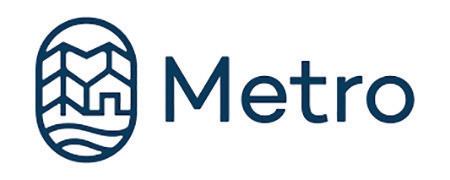
BY: METRO
US Real Gross Domestic Product (GDP) – Inflation adjusted production of goods and services in the US fell to the slowest seasonalized annual rate (SAAR) in 2024Q1. This is as most pundits and the Federal Reserve (FED) had thought would happen. Real GDP in Q1 slowed to 1.4% growth (SAAR), noticeably slower than the 4.9% and 3.4% growth rates seen in the two prior quarters, respectively. Slower output growth is consistent with a “softlanding” scenario, and one in which, if all goes well, the US is likely to avoid falling into a recession. Still, too high inflation persists. Consumers have cut back on real spending to the tune of 1.5% SAAR in Q1 as household purchasing power has been whittled down by excessive inflation. The current consumption rate is presently slower by half against the 2nd half of 2023 spending rate. Purchases of big-ticket items have declined, and so have discretionary items from gardening suppliers, sports equipment retailers, and department stores.
Bottom line: A downshift in underlying economic demand is evident. Consumers can’t spend as much and inventory levels have ticked up sharply in recent months, reflecting the hit on consumer pocketbooks from inflation. Net exports and domestic investments aren’t likely to contribute much towards accelerating GDP growth either, having recently peaked and leveled out. So, there is little chance of robust real GDP growth in the short run. Metro’s macroeconomic advisors have lowered its forecast of 2024 real GDP to 2.4%
US Inflation (Consumer Price Index – CPI) – Headline inflation remains a persistent problem, particularly for consumers who have had to pay upwards of 30% to 50% more on goods and services. The FED has made significant progress since headline CPI inflation topped 9.1% in June 2022. That inflation rate now stands at 3.3% (May 2024). The FED’s preferred inflation indicator is the measure of inflation leaving out food and energy prices; this is called core inflation and is less volatile, which reveals more of the economy’s underlying condition.
The monthly core inflation rate has been running a bit hotter than the overall CPI rate. More troubling is the BEA’s core inflation rate, which is tied very closely to consumers and real GDP. It jumped sharply to a 3.7% annualized rate in Q1 from 2.0% the quarter before.
Bottom line: The jump in the BEA’s core inflation rate caused the FED not to lower interest rates when they met as a committee in June. It had been widely expected from prior quarters that the FED would begin easing rates by this summer. Obviously, that outlook did not bear fruit as the federal funds rate remained at 5¼% -5½%. Most pundits and some in the FED believe a ¼ - point rate cut in December is likely if slower economic conditions continue playing out as expected in the next few months.
US Labor Market – Weaker US jobs data has the stock market feeling confident that the FED can cut rates later this year. US payroll growth slowed to +0.3% m/m in the month of June, compared to the +0.5% rate seen in each of the prior two months. Although, employment trends and growth cycles often operate at a significant lag from other economic indicators, it seems that the labor market is starting to align with slower US output. The US labor market continues to have resiliency in the face of elevated inflation and interest rates but has shown progress towards downshifting to slower growth. Most pundits believe that a period of sustained slower job growth is necessary to tame inflation and that appears to be happening. The 12-month job rate has slowed to below 2% growth in each of the last 5 months, notably slower rates from a year ago.
Bottom line: It seems the FED believes that hiring is slowing. Metro’s macroeconomic advisor believes that the cycle of slower job growth has manifested and evident for the FED to take the first step in cutting interest rates later this year.
Housing and the Construction Industry – The housing market took the
usual decline with the sharp engineered increase in mortgage interest rates but has recently shown signs of emerging out of that downturn. Permits for singlefamily (SF) construction have risen in each of the last 3 monthly readings from the Census. Multifamily construction permits continued its downward trajectory. NAHB’s homebuilder sentiment hit a nadir back in 2022-3, but readings have edged up, yet to the extent of where they were before the rate hikes. Mortgage originations also fell sharply with the sharp drop in new and existing home sales, due to high elevated housing costs. Those able to, early indications suggest home buyers (and sellers) have waited long enough, and there is subtly more residential inventory on the retail market despite affordability worries. Total housing production remains cyclically low, but the silver is that portions of it are trending up.
Bottom line: Mortgage rates will remain elevated until the FED decides to lower interest rates. Considerable angst for first time homeowner will persist in residential markets where housing demand outpaces supply. Home prices aren’t likely to diminish given these imbalances. Affordability will remain challenging as long as mortgage rates stay up. There is no expectation that nominal home prices will fall significantly, according to Metro’s macroeconomic advisor.
Consumer Sentiment: US consumer sentiment from the University of Michigan’s survey of consumers fell in the June reading by -1.3%. Sentiment readings have moved sideways from early this year, but on a tapering path after sharp gains late last year. Consumer expectations are little changed over the state of the economy, particularly in household finances, business outlook and labor market conditions. The fact that the indicator has edged lower in the last 3 months suggests that consumers are growing more frustrated at the lack of progress in taming current inflation rates.
Bottom line: Longer term they are reserving judgment until after the US election in November, which many consider
will have profound implications on the growth path of the US going forward. Consumers have resigned themselves to an outlook of higher inflation for some time longer and they’re expectations for what it will be remain elevated. The FED clearly has more work to do and to change the minds of consumers.
Regional economic growth: The unemployment rate in the MSA (4.1%) compares favorably against the US (4%). This is a bit deceiving when you take in other indicators. The Portland MSA region has the dubious distinction of having the worst job growth among its peer MSA regions. The Portland area ranks dead last, with a 12-month payroll of -1.2% growth. Las Vegas, Oklahoma City and Sacramento carry top honors with their payroll near or above 3% annual growth. Compared to the US, the region has also lagged badly in employment growth. After losing momentum in 2023, the S&P CaseShiller Portland area home price index has begun to accelerate in each of the last 3 months in which data are available. Higher
values have also materialized in the RMLS median home price. The June reading comes alongside a greater number of new listings, more home sales and a sharp drop in the average time on the market. The increase in sales is also reflected in a steady rise in SF home production in the region. MF production in the region remains mired in the doldrums. However, average apartment rental rates began edging up recently in the region, perhaps an omen of a residential rental market that can handle more unit production. In the next few years, the CHIPS Act (Creating Helpful Incentives to Produce Semiconductors and Science Act) is intended to lure and boost domestic investments in high-tech research and facilities. The hope is to bring semiconductor manufacturing back to the US. This region is uniquely situated and fortunate to utilize such investments, particularly because of Intel’s strong presence in this region.
Bottom line: Other things being equal, the full impact on high-tech job growth in Silicon Forest isn’t expected until later this decade and only modestly until the federal



program sunsets.
Population growth: Metro and PSU’s population research center issued brand new forecasts for the region. In these forecasts, both agencies have significantly downgraded their own population projections for the region. The State demographer agrees and so do Census Bureau forecasts. Annual growth rates have been cut in half to reflect the evidence that family sizes are declining, and women are on average having fewer children in their lifetime. The delay at which a woman has her first child has been pushed back by more than a decade, on average, and the cost of child rearing has become a larger pocketbook expense for many families.
Bottom line: With the region, State, and the US outlook, all showing much slower population growth, the long-run implication for the economy will likely be slower economic growth in the next 20 years than the previous generation. The economic outlook encapsulates fewer people chasing after fewer jobs and for output to be more subdued because of demographic changes.


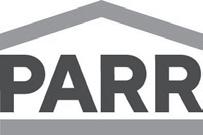

On December 7 last year, a Vancouver-area mom, Aubree Young, and her 6-month-old son, Kymani, were the victims of a tragic act of domestic violence. Aubree survived but with severe paraplegia (loss of leg function). Kymani did not survive his injuries.
Aubree’s family and her church community have rallied around her to provide some of the long-term care and support she’ll need as she recovers and adjusts from both the physical and emotional trauma. Her parents decided to construct an ADU on their property so that Aubree could live with some independence and also have space for the rehab equipment she needs.
Eric Hendrickson, Director of Construction for HBA member Oregon Homeworks, volunteered and devoted much of his free time to assisting with the construction of the ADU. Almost 40 trade contractors and suppliers also supported with free or discounted time and materials to help reduce the costs associated with the ADU construction.
The ADU was finished at the end of May and the family hosted an Open House to thank everyone who assisted with the project on May 31.
HBA would like to acknowledge and thank the following members who also supported the project:
Oregon Homeworks
Macadam Floor & Design
Builders FirstSource
James Hardie
Wolcott Services
Apex Air
Home Certified Sherwin-Williams



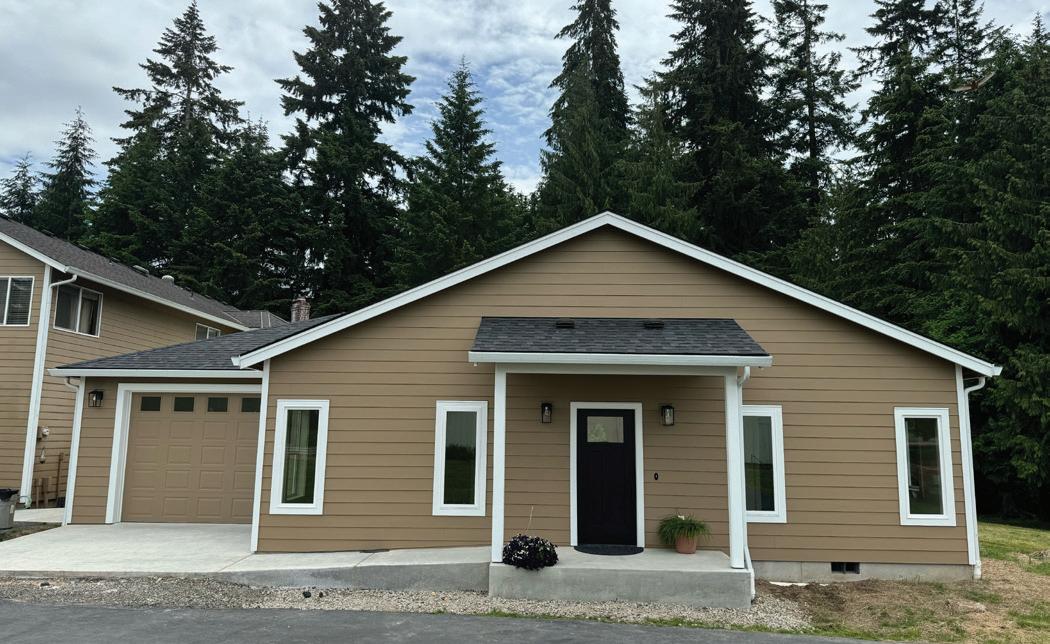
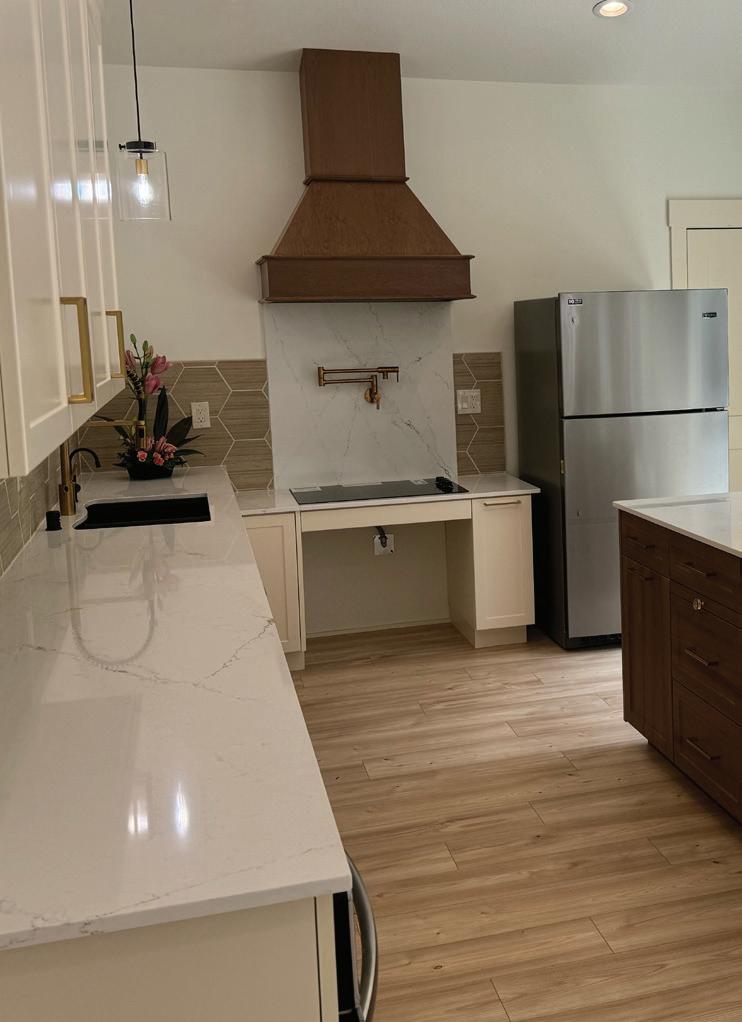
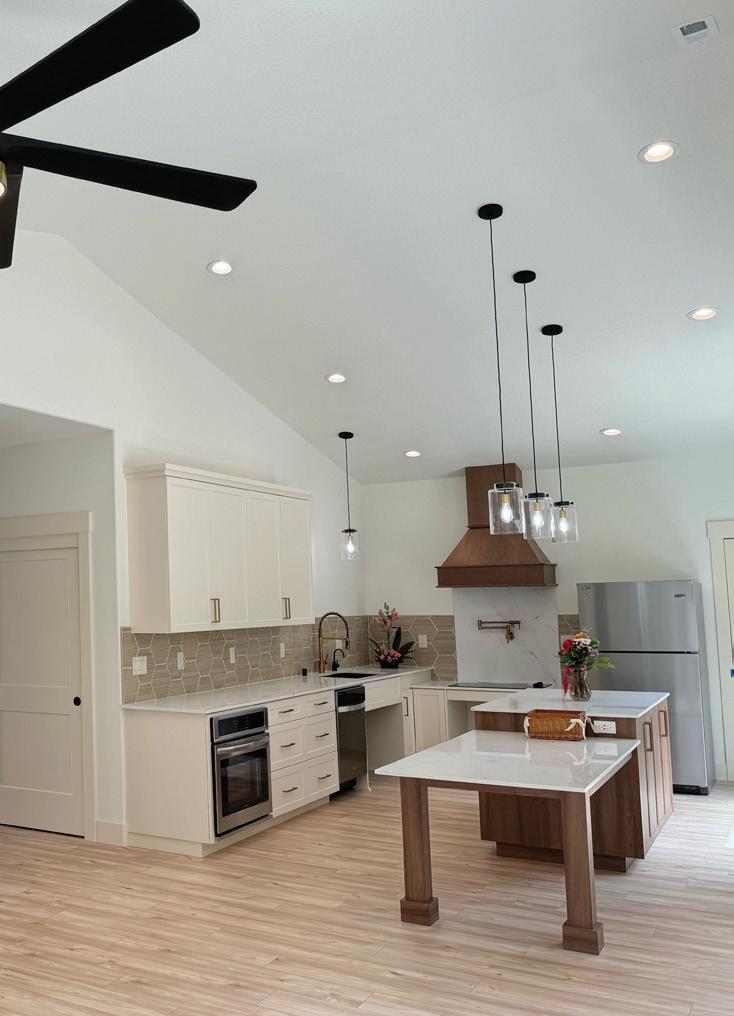


Visit hbapdx.org/events for the most up-to-date information and event registration details. If you would like to attend a meeting, check in advance to ensure there have been no schedule changes.
August 1
Nominating Committee, 11:30 am, HBA Offices
August 7
PBUD Council Meeting, 9:00 am, Zoom
August 8
HBF Executive, 8:30 am, HBA Offices + Zoom
Government Affairs, 10:00 am, HBA Offices + Zoom
August 22
HBA Board of Directors, 11:30 am, HBA Offices – First Floor
September 2
Labor Day –HBA Offices Closed
September 4
PBUD Council Meeting, 9:00 am, Zoom
September 5
Membership and Retention Committee, 10:00 am, HBA Offices + Zoom
September 11
HPC Council Meeting, 9:30 am, HBA Offices + Zoom
September 12
HBF Executive, 8:30 am, HBA Offices + Zoom
Government Affairs, 10:00 am, HBA Offices + Zoom
September 18
PWB Council Meeting, 10:00 am, HBA Offices + Zoom
September 19
HBF Board of Directors, 7:30 am, HBA Offices + Zoom
NW Natural Street of Dreams ON TOUR
August 1 – 18 | Extended Weekends Only, ThursdaysSundays - Scattered home sites across the greater Portland region
Realtor Day at the NW Natural Street of Dreams
August 6 | 11:00 am – 7:00 pm Cost: $25
Scattered home sites across the greater Portland region
Women in Construction Happy Hour at the NW Natural Street of Dreams
August 8 | 5:30 pm – 7:30 pm Freewell – a Prometheus Neighborhood
All Member Happy Hour at the NW Natural Street of Dreams
August 15 | 5:30 pm – 7:30 pm Home #1 on the tour – The Palisade by Garrette Custom Homes in Hillsboro
Home Building Foundation Trap Shoot
September 13 Portland Golf Club
All Member Happy Hour presented by Ferguson Bath, Kitchen & Lighting
September 19 | 5:30 pm – 7:30 pm Ferguson Bath, Kitchen & Lighting Gallery
2024 HBA Professional Women in Building Annual Retreat
September 20 – 21 The Stillwater Event Space
THE OFFICIAL PUBLICATION OF THE HOME BUILDING ASSOCIATION OF GREATER PORTLAND
HBA CEO Dave Nielsen
Associate Publisher Brian Monihan
Editor Samantha Thomas
Advertising Representative Chris Sweet
Graphic Design & Production Matias Ricco
Published by Carpenter Media Group
HBF – Home Building Foundation
H&G – Home & Garden Show
HPC – Home Performance Council
PBUD – Portland Building & Urban Development Council
RCB – Remodeling and Custom Building Council
PWB – Professional Women in Building Council
SOD – NW Natural Street of Dreams®
Take advantage of these exclusive member discounts from HBA business partners, visit hbapdx.org/benefits for

DISCOUNT GAS
For more information
contact Kathy Temple at 541-408-5155 Kathy.Temple@ edstaub.com

CREDIT CARD PROCESSING
For more information
contact Tim Holstein at 503-975-0660 timh@ swipenow.com

BUILDER/REMODELER MANUFACTURER
REBATE PROGRAMS
For more information contact Tami Walter, 503-684-1880 or tamiw@ hbapdx.org
9 New Members THANKS FOR JOINING!
Allwood Group Petersen, Scott 858-220-4246
Flooring - Wholesale
Boise Cascade Wood Products Way, Danny 541-335-1625
Building Materials
My Oregon Painting Inc. Guerra, Alejandro 971-269-4878
Painting Contractors
National Solar Reisner, Tyler 541-654-9350
Solar Energy Systems
Portland Spray Works, Inc. Zona, Deanna 503-701-6600 Finish Carpenters
The Management Trust Adzasu, Mildred 503-670-8111 Association Management

CONSTRUCTION INDUSTRY CRIME PREVENTION COUNCIL
For more information: www.cicpp.com
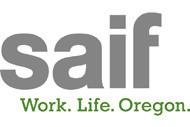
WORKERS COMPENSATION
Qualifying HBA members can save up to 7% on SAIF.

BENEFITS
For more information, contact the Program Manager at Capital Benefits Group at 425641-8093.
TNT Sales of Oregon, LLC. Wicks, Joanie 503-251-1242
Truck Sales/Leasing
BUILDER
Don Tankersley & Co Tankersley, Don 503-232-0918
General Contractor
PROActive Development LLC Miller, David 503-806-6603
General Contractor
65 Renewed Members THANK YOU FOR RENEWING YOUR MEMBERSHIP!
30-39 Years
Big Bear Const. Co.
BMDA
Kitchens & More Northwest
Ofstad Management Co.
Power Plumbing Co.
Sundeleaf Painting, Inc.
Town & Country Fence Co. of Oregon
20-29 YEARS
2-10 Home Buyers Warranty
Camp’s Lumber
Don Herbst Painting Inc.
Fisher Roofing
NW Natural
Precision Truss & Lumber, Inc.
Stafford Homes & Land LLC
10-19 YEARS
Affinity Home & Design
ARTIS
Bernard Painting Inc
Brian Schmidt Builder
Buffalo Welding, Inc
Cascade Hasson Sotheby’s International Realty
DT Glass, Inc.
Emmert International
Haven Spa, Pool, & Hearth
Highland Ridge Custom Home Remodeling
Intrepid Marble & Granite
KDF Enterprises LLC
Milwaukie Lumber Co.
Mission Homes NW, LLC
Murrayhill Remodeling Co.
Noyes Development Co.
NW Development Inc.
Oregon Homeworks, LLC
Performance Insulation & Energy Services
Petrina Construction Inc
Planning & Land Design
Precision Countertops
Red’s Electric
SFW Construction LLC /
Yeah Dude Rentals LLC
Stone Center Inc
SwipeNow
The Kelly Group
THE Remodel Group
Urban Visions Planning Systems
Westside Drywall & Insulation
AC General Contracting
Apostolos Painting
Cadwell Landscaping LLC
Craft Homes Northwest
Jenkins Painting, LLC
Oregon Restoration Co.
Oregon Truss
PayneWest Insurance
Roost Homes LLC
TECHIFI
Tonya Shirk LLC
TRC
GLC Homes
Infinity Excavating Inc.
K2 Stone
LGI Homes
Nova USA Wood Products
Pella Corporation
Premier Central Vac
RHW Investments LLC
Ziebart Construction, LLC

BY: BILL JOSEPH
Back when the Oregon Construction Contractors Board (“CCB”) adjudicated claims involving contractors, it provided a good venue for litigating matters involving $25,000 or less. However, the CCB stopped offering that service well over a decade ago. Now, the CCB merely offers mediation. If a CCB complaint is not resolved via mediation, complainant must obtain a court judgment against the contractor and deliver the judgment to the CCB before the CCB will decide whether to allow complainant to obtain compensation from the contractor’s CCB bond. Unless a construction contract provides for a different venue—e.g., arbitration—the Small Claims Court can provide a good venue for quickly and economically resolving small monetary disputes between consumers and contractors, or contractors and subcontractors. However, the small claims process is also fraught with pitfalls for the unwary litigant.
All Oregon county courts have a Small Claims and/or Justice Court division, which are governed by separate sets of procedural rules from those governing the Circuit Court Civil Divisions. Justice Courts are governed by yet another separate set of procedural statutes, although they are largely the same as those governing Small Claims Court. Both courts’ jurisdiction is limited to disputes of $10,000 or less. Attorneys are typically not allowed in Small Claims or Justice Court absent court approval. Indeed, Small Claims and Justice Courts are some of the few venues where corporate entities can be represented by a non-attorney principal. Individuals can also of course represent themselves. On the other hand, if you do obtain court approval to be represented by counsel, Small Claims and Justice Courts do not have the ability to award attorney fees should you be the prevailing party.
A small claim is initiated by filing a claim, which is a form downloadable from the court’s website and paying a minimal filing fee. Whereas most Circuit Court complaints must be personally served, small claims need only be served via certified mailed. Small Claims and Justice Court cases are subject to shorter time frames than Circuit Court cases. For instance, once served, a defendant only has 14 days to respond to a claim by filing a response, which is also available as a downloadable form. If a defendant does not respond within the applicable time, it is at risk of entry of a default judgment from which procedural rules offer limited options for appeal. As such, it is important that you not ignore but respond to any Small Claims Court complaint with the time permitted so as to avoid a default.
A defendant can file a counterclaim in response to a small claim but is again limited to claiming $10,000 or less. If a defendant seeks more than $10,000, the matter is transferred to Circuit Court.
Many construction contracts call for some form of alternative dispute resolution, such as mediation or arbitration, in which case the Small Claims or Justice Court typically lacks jurisdiction. If this is the case, then defendants should make known in their response to a small claim that the parties are contractually required to mediate or arbitrate, in which case the court may
abate or dismiss the claim for lack jurisdiction, depending on the wording of the contract.

Small claims can be decided on the pleadings, meaning without a hearing. Or the parties can request a hearing before a judge or jury by making the appropriate selection on their claim or response form and paying another fee. Whereas most Small Claims and Justice Court matters are heard by a judge without a jury, when either of the parties request a jury, the court will impanel a jury of only 6 people, as opposed to the typical 12 jurors in Circuit Court trials. Small Claims and Justice Court matters are typically decided within a few months of filing, as opposed to Circuit Court matters, which can take over a year to reach a decision.
Once decided, Small Claims and Justice Court judgments are subject to only very limited rights of appeal. Parties can seek review of the Circuit Court by filing a writ of review, although review is limited to derogation of law, meaning the court will typically not rehear the facts at issue. Small Claims and Justice Court judgments are enforceable like any other court judgment, including the ability to issues writs of garnishment to banks and employers, and writs of execution against real and personal property.
Ultimately, if the parties get to the stage of litigating a Small Claims or Justice Court matter, they should be aware that the process is technically complex and fraught with pitfalls. As such, I recommend that parties seek the advice of competent counsel familiar with Small Claims and Justice Courts early in the process.
Bill Joseph is a partner at Portland law firm Dunn Carney, LLP and the leader of the firm’s Construction & Design Team. He also serves as the HBA’s general counsel. His practice focuses on business litigation and transactional law with a specific emphasis on helping those in construction and related industries.





HBA’s Political Action Committee, OFAH, supports pro-housing candidates and measure at the local and state level We advance policies that support the entire housing industry while directly challenging antidevelopment activities. Our work ensures that Oregonians, regardless of income, have access to diverse and affordable housing options.
BY REGENCE
Extreme heat can be dangerous
Be sure to stay hydrated and keep kids hydrated. Never leave kids or pets in the car on a hot day, even for a short time. Check up on the older people in your life every couple of days during a heat wave to ensure they are staying cool and hydrated.
Heat exhaustion occurs when you are exposed to high temperatures, particularly when combined with high humidity. Signs and symptoms can develop suddenly or over time, especially with prolonged periods of exercise. Heat exhaustion symptoms include:
• Moist skin with goose bumps when in the heat
• Heavy sweating
• Dizziness
• Fatigue
• Weak, rapid pulse
• Muscle cramps
• Headache
• Fainting (passing out)
If you experience symptoms of heat exhaustion, stop all activity and rest. Find a cool place for your body to cool down and drink cool water. Heat exhaustion, if left untreated, can progress to heat stroke.
BY: JOE SEIFERT, DELAP LLP
In today’s digital age, IT infrastructure is as crucial to construction companies as the foundations of the buildings they construct. Just as a well-fortified castle protects the treasures within, your organization’s cybersecurity controls protect the mission-critical networks, systems, and data your teams rely on to operate. However, when an organization has a workforce spread across remote job sites, the challenge of protecting its critical infrastructure becomes more akin to securing multiple small outposts far beyond its castle’s walls. When employee laptops and mobile devices “go beyond the castle walls,” the devices, the systems they connect to, and the data they contain are all exposed to different risks than if they stayed in the office (i.e., the “castle”). As that rather obscure castle architecture-based cybersecurity analogy seems to be sufficiently exhausted, let’s explore a few key best practices for securing employee devices, network access, and off-site data for organizations with dispersed workforces.
What is heat stroke?
Heat stroke occurs when your body overheats, usually due to extended exposure to or physical effort in hot temperatures. Heat stroke can happen when the body’s temperature rises rapidly and the body is unable to cool down with sweating. Heat stroke symptoms include: Altered mental state or behavior, such as confusion and slurred speech

• High body temperature (103°F or higher)
• Hot, red, dry or damp skin
• Nausea and vomiting
• Rapid breathing
• Racing heart rate
• Headache
• Dizziness
• Losing consciousness (passing out)
If you or someone you know starts experiencing symptoms of heat stroke, seek medical attention immediately.
A Virtual Private Network (VPN) provides employees with a way to establish an encrypted connection from a remote network into your organization’s corporate networks and resources. A VPN should be configured with strong encryption protocols and should enforce multi-factor authentication (MFA) for an added layer of security. Employees should be trained to use the VPN connection anytime they connect their company laptops and devices to public Wi-Fi networks. When a VPN is implemented, all the files remote employees may need while on the jobsite can be stored within the secure corporate network. It does not matter if a laptop is connected to a coffee shop Wi-Fi network or tethered to their phone — as long as the employee connects to the VPN, they will be able to access those files just as if they were sitting in the office.
Disk encryption is a critical security measure for mobile devices such as employee laptops. Encrypting the data on a laptop’s hard drive
ensures that even if the device is lost or stolen, the data it contains remains secure and inaccessible to unauthorized users. Implementing disk encryption is straightforward and inexpensive. Enterprise versions of Windows have the BitLocker disc encryption utility built in.
Finally, it is important to understand that technical controls such as the ones we have outlined here are ineffective if your employees don’t know how to use them. According to the 2023 Verizon Data Breach Investigations Report, 82% of all data breaches involved the human element. This underscores the critical importance of educating your employees about cybersecurity best practices and how to utilize the security tools you provide them. Every “outpost” beyond your castle’s walls must be secured; however, it is also very important that they understand how to keep themselves safe!
If you or your organization have questions regarding the cybersecurity implications of a remote workforce or about the latest security best practices, Delap’s IT Assurance team would love to chat!
BY BRAD NANKE, OHBA
During the summer there is usually a lot of emphasis on protecting skin from UV rays during the summer. But one must not forget about protecting the eyes—the most exposure to bright sunlight increases the risk of developing cataracts, macular degeneration, and growths on the eye including cancer. July is UV safety awareness month. However, eyes are at risk to UV rays all year round. It is important to protect the eyes from UV rays in all situations by wearing proper eye protection—UV blocking sunglasses.
The hours between 10 a.m. and 4 p.m. daylight savings time (9 a.m. to 3 p.m. standard time) are the most hazardous for UV exposure in the continental United States. UV rays are the greatest during the late spring and early summer in North America.
Ultraviolet (UV) Light
Ultraviolet (UV) rays are an invisible kind of radiation that comes from the sun, tanning beds, and sunlamps. UV rays can penetrate and change skin cells.
The three types of UV rays are ultraviolet A (UVA), ultraviolet B (UVB), and ultraviolet C (UVC) — Here are some tips from the American Academy of Ophthalmology:
• Don’t focus on color or darkness of sunglass lenses: Select sunglasses that block UV rays. Don’t be deceived by color or cost. The ability to block UV light is not dependent on the price tag or how dark the sunglass lenses are.
• Check for 100 percent UV protection:

Make sure your sunglasses block 100 percent of UV-A rays and UV-B rays.
• Choose wrap-around styles: Ideally, your sunglasses should wrap all the way around to your temples, so the sun’s rays can’t enter from the side.
• Wear a hat: In addition to your sunglasses, wear a broad-brimmed hat to protect your eyes.
• Don’t rely on contact lenses: Even if you wear contact lenses with UV protection, remember your sunglasses.

• Protect your eyes during peak sun times: Sunglasses should be worn whenever outside, and it’s especially important to wear sunglasses in the early afternoon and at higher altitudes, where UV light is more intense.
• Never look directly at the sun. Looking directly at the sun at any time, including during an eclipse, can lead to solar retinopathy, damage to the eye’s retina from solar radiation.
• Don’t be fooled by clouds: The sun’s rays can pass through haze and thin clouds. Sun damage to eyes can occur anytime during the year, not just in the summertime.




















Get ready to fall hard. Fulgor Milano luxury appliances are the perfect match for your life and your kitchen. The 48” So a Professional induction range is available in two models - seven induction cooking zones, or ve induction cooking zones and a dual-zone induction powered griddle in addition to powerful primary and secondary convection ovens meticulously handcrafted in Italy for the North American home. Amore




